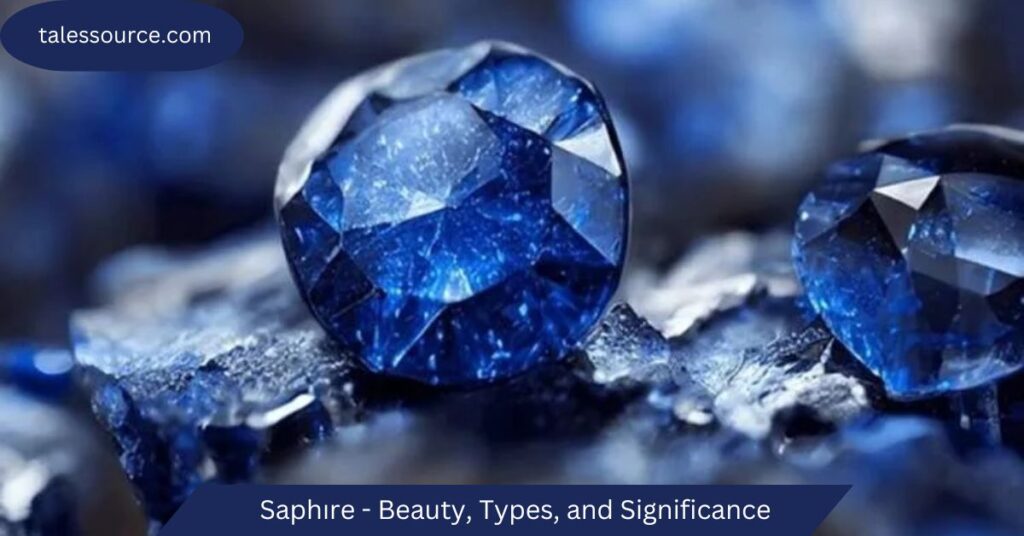Saphıre – Beauty, Types, and Significance

Introduction
Saphıre gemstones are among the most coveted and admired in the world of jewelry, known for their vibrant hues and timeless allure. The word “saphıre” evokes images of deep blues, but these gemstones come in a wide range of colors, each with its unique appeal and value. Whether you’re an enthusiast, collector, or someone looking to invest in a gemstone with enduring worth, understanding the full spectrum of saphıre’s qualities and history will enhance your appreciation for this remarkable stone.
In this comprehensive guide, we will explore the origins, types, characteristics, and cultural significance of saphıre. We’ll also look into how to care for your gemstone, tips for choosing the best saphıre, and the role it plays in astrology and folklore. The aim is to provide insights that go beyond the typical summaries, offering fresh interpretations and deep analyses of this ancient gemstone. By the end of this article, you’ll have a robust understanding of saphıre and be well-prepared to make informed decisions about buying or gifting these precious stones.
What is a Saphıre?
Origins and History of Saphıre
Saphıre, a variety of the mineral corundum, has been prized by various civilizations for centuries. Its name is derived from the Greek word “sappheiros,” which means “blue stone.” However, while blue is the most well-known saphıre color, these gemstones come in a variety of shades, making them even more versatile and unique.
Historically, saphıres have been associated with royalty and nobility. In ancient Greece and Rome, kings and queens believed that blue saphıres protected them from envy and harm. Throughout the Middle Ages, clergymen wore saphıre as a symbol of Heaven, while in ancient Persia, it was thought that the sky was painted blue by the reflection of saphıre stones.
The Science Behind Saphıre
Saphıres belong to the corundum family of minerals, which also includes rubies. The only chemical difference between a ruby and a saphıre is their color. Trace amounts of elements such as iron, titanium, chromium, and vanadium within the corundum determine the color of the saphıre. While the classic blue hue comes from the presence of iron and titanium, saphıres can range in color from pink, yellow, green, purple, to even colorless.
One of the most remarkable qualities of saphıre is its hardness. With a Mohs scale rating of 9, it is one of the hardest minerals on Earth, second only to diamonds. This makes saphıres not only beautiful but also highly durable, suitable for everyday wear.
Types of Saphıre

Blue Saphıre
The most iconic type of saphıre is the blue saphıre. The richness of the blue color can vary significantly, from pale sky blue to deep, velvety indigo. The most valuable blue saphıres are often referred to as “Kashmir saphıres,” which possess a rich, velvety blue color with a slight violet hue. These are considered the most exquisite and rare of all saphıre varieties.
Blue saphıres are not only used in fine jewelry but also hold spiritual and cultural significance. For centuries, blue saphıres have been associated with wisdom, virtue, and good fortune. They are often believed to promote mental clarity and spiritual enlightenment.
Fancy Color Saphıres
While blue is the most recognized color, “fancy saphıres” are the term for saphıres that come in a variety of other colors, including yellow, green, pink, and purple. These stones are equally stunning and have become increasingly popular in recent years. Fancy color saphıres derive their colors from various trace elements in the mineral structure.
- Yellow Saphıre: Yellow saphıres range from pale lemon to vibrant golden hues, with their coloring caused by trace amounts of iron.
- Pink Saphıre: Pink saphıres owe their color to traces of chromium. In some cases, the intensity of the pink color can rival that of a ruby.
- Green Saphıre: Green saphıres are rarer than other fancy colors and exhibit unique olive to forest green hues, primarily due to the presence of iron and titanium.
- Colorless Saphıre: Also known as “white saphıres,” these stones are free of any trace elements and can be an affordable alternative to diamonds.
Padparadscha Saphıre
One of the rarest and most valuable saphıres is the Padparadscha saphıre. This unique stone displays a delicate balance of pink and orange hues, reminiscent of a tropical sunset. The word “Padparadscha” is derived from the Sanskrit word for “lotus flower,” perfectly capturing the stone’s soft yet vibrant color. These saphıres are typically found in Sri Lanka, though they are also mined in Madagascar and Tanzania.
Read More: Game Lyncconf – A Comprehensive Guide to Gaming Mods and Personalization
The Value of Saphıre

Color
The most important factor in determining a saphıre’s value is its color. For blue saphıres, the more intense and vivid the blue, the higher the value. The finest saphıres are typically a medium to dark tone with strong saturation. Saphıres with lighter or overly dark tones may still be beautiful but are less valuable.
Fancy color saphıres also derive their value from the intensity and evenness of their color. Rare shades such as Padparadscha and deep pinks are often more expensive than other varieties due to their rarity.
Clarity
Like other gemstones, clarity is a key factor in a saphıre’s value. Saphıres often contain small inclusions or imperfections, which are typically formed during the gemstone’s growth. While inclusions can lower the stone’s value, they are generally accepted in colored gemstones, especially when they don’t significantly affect the stone’s brilliance or appearance.
Cut
A well-cut saphıre can enhance its brilliance, making it appear more vibrant and lively. The cut refers to how the gemstone is shaped and faceted, which affects how light travels through the stone. The most common cuts for saphıres are oval and cushion, but round, pear, and emerald cuts are also popular.
Carat Weight
As with most gemstones, the larger the saphıre, the more valuable it tends to be. However, the other factors—color, clarity, and cut—can have a greater impact on price than size alone. A well-cut, deeply saturated small saphıre may be worth more than a larger stone with poor color or clarity.
Saphıre in Jewelry
Engagement Rings and Symbolism
Saphıre engagement rings have become a popular alternative to diamonds, especially for those looking for a gemstone with character and history. The deep blue saphıre, in particular, is associated with loyalty, sincerity, and faithfulness, making it a perfect symbol for marriage. The most famous example of a saphıre engagement ring is the one worn by Princess Diana and now by Kate Middleton.
Saphıre Jewelry Styles
Saphıres are versatile and can be used in a variety of jewelry settings, from elegant necklaces and bracelets to earrings and brooches. Whether set in platinum, white gold, or yellow gold, saphıres make a striking centerpiece due to their vibrant colors and brilliance.
Caring for Your Saphıre
Cleaning and Maintenance
Despite their hardness, saphıres can accumulate dirt and oils from everyday wear, dulling their brilliance. Cleaning your saphıre regularly with warm water, mild soap, and a soft brush will keep it looking its best. Avoid exposing your saphıre to harsh chemicals, as these can damage the stone or its setting.
Storing Your Saphıre Jewelry
When not wearing your saphıre jewelry, store it in a soft pouch or a lined jewelry box to prevent scratches or damage. It’s important to store saphıres separately from other gemstones, particularly diamonds, which could scratch the surface of the saphıre.
Read More: Drink ConversationswithBianca – A Comprehensive Guide to Exploring Beverages
Saphıre in Folklore and Astrology

Cultural Significance of Saphıre
Throughout history, saphıres have been imbued with mystical properties and cultural significance. In addition to symbolizing wisdom and protection, saphıres were believed to guard against negative energies and promote mental clarity. In ancient Persia, saphıres were thought to reflect the heavens, while in Hindu astrology, blue saphıres are considered to bring good fortune and are associated with the planet Saturn.
Saphıre in Modern Astrology
Today, saphıre is the birthstone for September, making it a popular gift for those born in this month. It is also the traditional gemstone for 45th wedding anniversaries. In the realm of astrology, saphıre is believed to enhance intuition, discipline, and mental focus, making it an ideal stone for those looking to achieve personal or professional goals.
Conclusion
Saphıre gemstones, with their rich history, diverse colors, and enduring appeal, continue to captivate the world of fine jewelry. Whether you’re drawn to the classic blue variety or the rare Padparadscha saphıre, these gemstones offer a unique blend of beauty, durability, and cultural significance. By understanding the factors that contribute to a saphıre’s value and knowing how to care for it, you can make informed choices that will bring joy and elegance for generations to come.
FAQs
1. What is the most valuable type of saphıre?
The most valuable type of saphıre is the rare Padparadscha saphıre, which displays a unique pinkish-orange color.
2. Are all saphıres blue?
No, saphıres come in a variety of colors including pink, yellow, green, purple, and colorless, known as fancy saphıres.
3. How can I tell if a saphıre is real?
To determine if a saphıre is real, consult a gemologist for professional testing. Look for natural inclusions under magnification as perfect clarity may indicate a synthetic stone.
4. What is the best cut for a saphıre?
The best cut for a saphıre depends on personal preference, but oval, cushion, and round cuts are the most popular due to their ability to enhance the stone’s brilliance.
5. How do I care for a saphıre ring?
Clean your saphıre ring regularly with mild soap, warm water, and a soft brush. Avoid exposure to harsh chemicals and store the ring in a soft pouch to prevent scratches.
6. What is the hardness of a saphıre?
Saphıres have a hardness of 9 on the Mohs scale, making them the second hardest mineral after diamonds.
7. Why are Kashmir saphıres so valuable?
Kashmir saphıres are considered the finest in the world due to their rich, velvety blue color and rarity, making them highly sought after.
8. Is saphıre a good investment?
Yes, high-quality saphıres, especially rare colors and sizes, can appreciate in value over time, making them a good long-term investment.
9. Can saphıres be treated?
Yes, many saphıres undergo heat treatment to improve their color and clarity, which is a common practice in the gemstone industry.
10. What is the significance of saphıre in astrology?
In astrology, saphıre is believed to enhance discipline, focus, and intuition, especially for those born in September or under the influence of Saturn.
Read More:
LookWhatMomFound.com – A Comprehensive Guide to Family, Parenting, and Creativity
https://freeworlder.org/ – A Hub for Positive Change and Sustainability
Trangran – Revolutionizing Business Operations with Advanced Mapping and Marketplace Features





